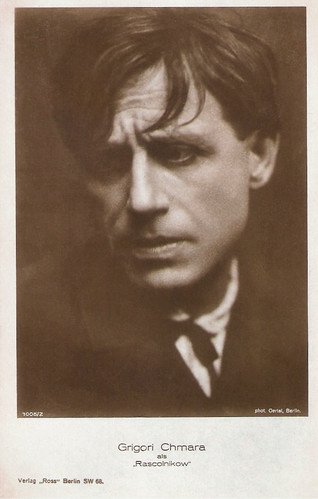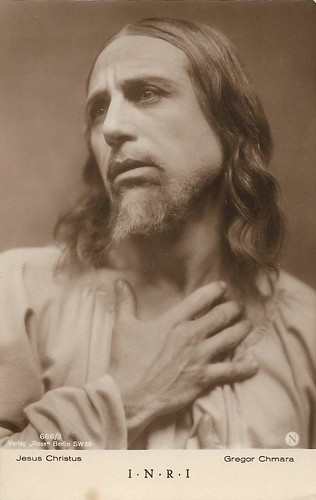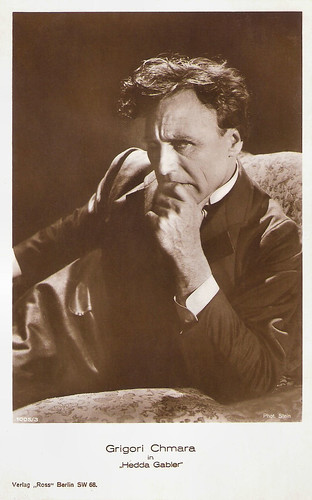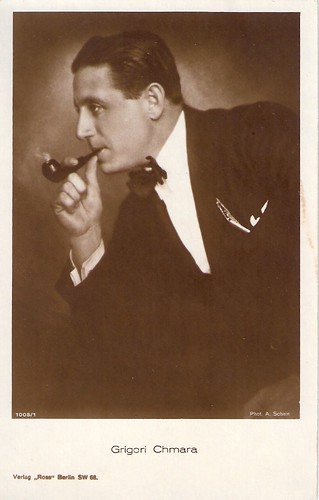
German postcard by Ross Verlag, Berlin, no. 1005/2, 1927-1928. Photo: Oertel, Berlin. Publicity still for Raskolnikow (Robert Wiene, 1923).

German postcard by Ross Verlag, no. 580/3, 1919-1924. Photo: Art Film. Asta Nielsen and Gregori Chmara in Der Absturz/Downfall (Ludwig Wolff, 1923).

German postcard by Ross Verlag, Berlin, no. 666/3. Photo: Neumann. Gregori Chmara as Jesus Christ in the Biblical film I.N.R.I. (Robert Wiene, 1923).
The Duse of the silent film
Gregori Chmara, a.k.a. Grigori Chmara, Grigori Khamara and Grégory Chmara, was born in Poltava, Russian Empire (now Ukraine), in 1882 (according to IMDb in 1893). In 1910 he debuted at the Moscow Art Theatre, getting lead roles from 1912 on.
He made his film debut in the Russian production Sverchok na pechi (Boris Sushkevich, Aleksandr Uralsky, 1915), an adaptation of Charles Dickens' 'The Cricket on the Hearth'. Chmara played opposite Maria Ouspenskaya and Michail Chekhov, a nephew of playwright Anton Chekhov, and both pupils of innovative theatre director Konstantin Stanislavski. Chmara next played in Yevgeni Bauer's Koroleva ekrana/Queen of the Screen (1916) and some films of Joseph Soiffer.
After the Russian Revolution, he moved to Germany, probably around 1921. Chmara became a popular star in Berlin with his gipsy songs, accompanying himself on the guitar. During one of these music nights, he conquered Asta Nielsen, the Duse of the silent film. They became lovers and stayed together for years without ever marrying. In 1922 Nielsen provided Chmara his first German film role in Der Absturz/Downfall (Ludwig Wolff, 1923), a film produced by Nielsen herself. It was the start of a very productive period in Chmara's career.
In the expressionistic classic Rasknolnikow (Robert Wiene, 1923), he played the title role, surrounded by an all-Russian cast. The film was an adaptation of Fyodor Dostoyevsky's 'Crime and Punishment'. In I.N.R.I./Crown of Thorns (Robert Wiene, 1923), he played Jesus opposite Asta Nielsen as Maria Magdalena and Henny Porten as Mary. Remarkable casting while Nielsen and Porten were rival stars in the 1910s. After this, seven more films followed with Asta Nielsen, culminating in a small part in Die Freudlose Gasse/The Joyless Street (Georg Wilhelm Pabst, 1925). Chmara then did not appear in films for a few years.
When he restarted in 1928 it was not opposite Nielsen anymore. This could be the result of a boycott against Nielsen in 1925-1927 because of her critique of the film industry. The right-wing reaction against Die Freudlose Gasse might have been another motive for his absence. Hugo Bettauer, the author of the novel on which Die Freudlose Gasse was based, was murdered during the shooting of the film. Several countries forbade the film. Critics of the left heralded it instead. When exactly Nielsen and Chmara split is unknown. After 1927 Nielsen returned to the stage where she successfully acted for years, apart from her only sound film, Unmögliche Liebe/Crown of Thorns (Erich Waschneck, 1932).

German postcard by Ross Verlag, Berlin, no. 667/3. Photo: Neumann. Gregori Chmara as Jesus Christ at the Last Supper in the Biblical film I.N.R.I. (Robert Wiene, 1923). Foreground right, looking up is Alexander Granach as Judas.

German postcard by Ross Verlag, Berlin, no. 1005/3, 1927-1928. Photo: A. Schein. Publicity still for Hedda Gabler (Franz Eckstein, 1925).
Rasputin
In 1928 Gregori Chmara appeared in three German films. In the historical drama Dornenweg einer Fürstin/The Difficult Path of a Princess (Nikolai Larin, Boris Nevolin, 1929), he played Rasputin, the Russian mystic largely responsible for the 1917 collapse of the Romanov dynasty. Chmara did one film in Poland, the crime mystery Mocny czlowiek/A Strong Man (Henryk Szaro, 1929), in which he had the leading role, and then he moved back to Germany to start making sound films.
He played in both the French and the German versions of L'homme qui assassina/Der Mann der den Mord beging/The Man Who Committed the Murder (Curtis Bernhardt, 1930) starring Conrad Veidt.
Films followed like the comedy Peter Voss, der Millionendieb/Peter Voss, the Thief of Millions (Ewald André Dupont, 1932) starring Willi Forst, and Der Diamant des Zaren/The Diamond of the Czar (Max Neufeld, 1932) with Liane Haid. In the same period, Chmara travelled around with the so-called Group of Prague, which consisted of fled Russian actors. In 1929 for instance they performed in 'Raskolnikow' in Belgrade.
In 1933 Chmara met Lila Kedrova in Paris, during one of his theatre tours and she became his new lover until 1940. He introduced her to the Stanislavski Method. Chmara himself though was handicapped because he refused to learn French, and he thus survived singing in Russian cabarets.
In 1940 he met Vera Volmane, a Russian film journalist, and they became a couple. During and after the war, she wrote sketches for him and adaptations of plays. Because of his strong accent, Chmara's roles in post-war cinema and theatre were limited to exotic characters, though he also played the classic Russian and Scandinavian authors on stage.

German postcard by Ross Verlag, Berlin, no. 1005/1, 1927-1928. Photo: A. Schein.

German postcard by Ross Verlag, no. 162/2. Photo: Ufa. Conrad Veidt, Grigori Chmara and Wolf Albach-Retty in Der schwarze Husar (Gerhard Lamprecht, 1932).
The Stanislavski method
In post-war cinema, Gregori Chmara had small roles or even bit parts, from Un ami viendra ce soir/A Friend Will Come Tonight (Raymond Bernard, 1946) and Jo-la-Romance (Gilles Grangier, 1949) starring Georges Guétary to the Sartre adaptation Les mains sales/Dirty Hands (Fernand Rivers, Simone Berriau, 1951).
He played Elena's domestic in Elena et les hommes/Paris Does Strange Things (Jean Renoir, 1956) with Ingrid Bergman. He also had a bit part in the Swiss film Die Vier im Jeep/Four in a Jeep (Leopold Lindtberg, 1951), a drama about post-war Vienna, that won the Golden Bear at the first Berlin International Film Festival.
In the 1950s, Chmara was considered as one of the true heirs and pupils of Stanislavski. He gave acting lessons, e.g. to Pierre Brice.
Chmara had occasionally small film roles during the 1960s. These films included Arsène Lupin contre Arsene Lupin/Arsene Lupin vs. Arsene Lupin (Edouard Molinaro, 1962). His last role was a return to Raskolnikow when he had a small role in Crime et châtiment/Crime and Punishment (Stellio Lorenzi, 1971), a French TV version of Dostoyevsky's classic novel.
Before it aired, Gregory Chmara died in Paris in 1970. In 1979 Vera Volmane and film critic Charles Ford published 'Grégory Chmara, l'homme expressif'. In 1980 Volmane and Ford introduced the Prix Grégory Chmara, for the best theatre or film actor and actress in a certain role of that year.
A tipsy Prince Cernuwicz played by Gregori Chmara in Der Mann, der den Mord beging/The Man Who Committed the Murder (1930), with Heinrich George and Conrad Veidt. Source: Parysia 77 (YouTube).
Another scene from Der Mann, der den Mord beging/The Man Who Committed the Murder (1930) with Gregori Chmara, Heinrich George and Conrad Veidt. Source: Parysia 77 (YouTube).
Source: IMDb, Wikipedia (Danish) and Russie-europe (French).
This post was last updated on 24 September 2023.
No comments:
Post a Comment